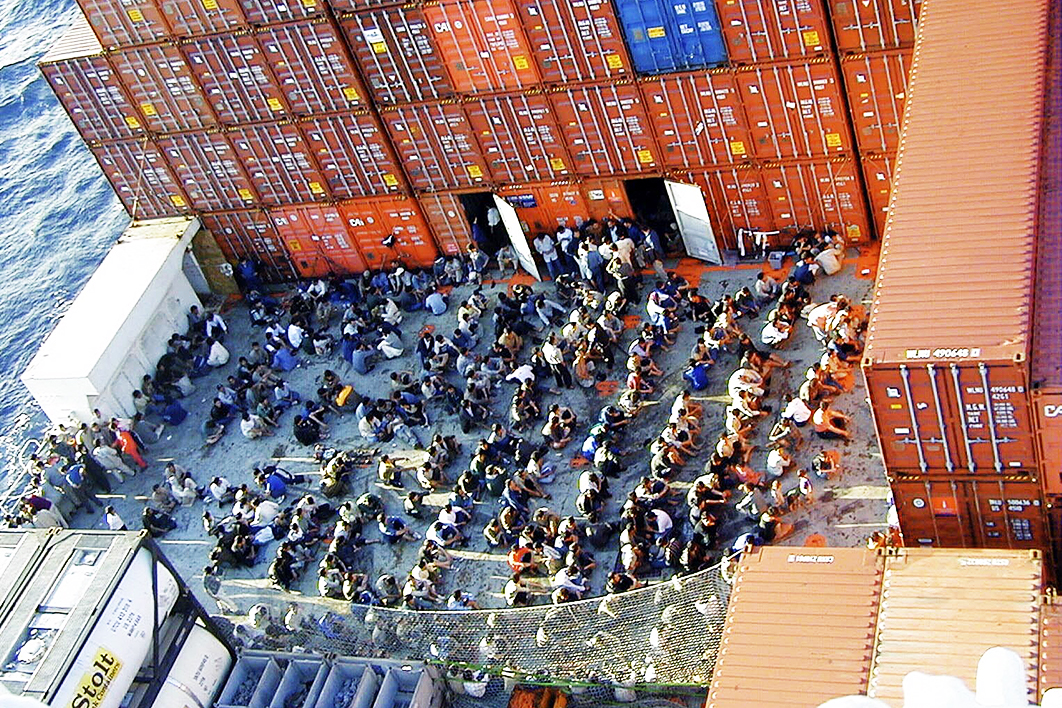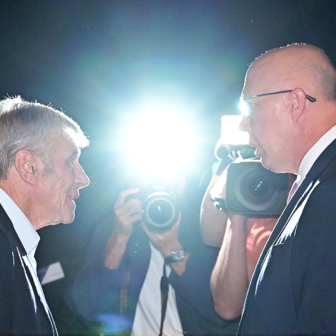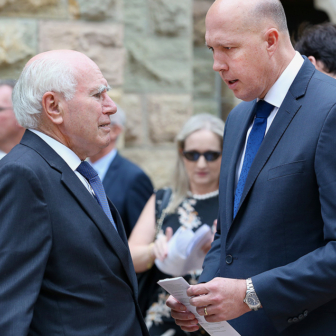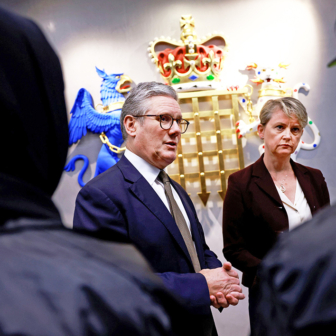With the world watching in horror as the window closes on evacuation efforts at Kabul airport, it’s hard to avoid the comparison with another drama, twenty years ago, involving Afghans fleeing a Taliban regime. The window to safety was blocked back then, too, but it was closer to home, on the waters around Christmas Island.
On the morning of Sunday 26 August 2001 the Tampa, a Norwegian freighter, diverted from its route from Fremantle to Singapore to go to the aid of a small Indonesian boat, the Palapa 1, adrift in heavy seas with a failed engine. The Tampa had been alerted to the boat’s plight by the Rescue Coordination Centre at the Australian Maritime Safety Authority in Canberra, and was guided most of the way to the scene by a plane from Coastwatch, the surveillance arm of the Australian Customs Service.
By the time the Tampa reached the wooden vessel it was breaking up in the swell. Australian authorities had warned the Norwegian vessel to expect to find eighty or more people aboard. But by the time the dangerous high-seas rescue was complete, the Tampa’s twenty-seven crew members had been joined by another 438 people — 433 asylum seekers, all but nine of them from Afghanistan, and the Palapa’s five Indonesian crew.
In responding to Australia’s call, captain Arne Rinnan and his crew not only demonstrated great courage, they also observed a foundational principle of seafaring enshrined in the Convention for the Safety of Life at Sea — “a general obligation for masters to proceed to the assistance of those in distress.” Yet they got no thanks from the government in Canberra.
When the Tampa reached the Palapa, it was only about four hours from Christmas Island. But with the distressed boat technically in the Indonesian maritime rescue zone, Captain Arne Rinnan was directed to land the rescued asylum seekers at the Indonesian port of Merak, more than twelve hours away. As he steered towards Java, an agitated delegation came to see him. The five men were threatening that people could jump overboard or riot if the Tampa did not change course. Recalling the moment in a feature to mark the twentieth anniversary of the Tampa affair for Radio National’s The History Listen, the vessel’s chief officer, Christian Maltau, described the men as rude and very aggressive: “We never felt really threatened, but everything on board was very confusing.”
Concerned for the safety of all on board, Rinnan consulted Australia’s search and rescue authorities. He was advised that, as master, it was up do him to decide what to do. This is another key plank of the international convention: “the role of the Master in exercising his professional judgement over decisions necessary to maintain the security of the ship.”
Erring on the side of caution, Rinnan opted to make for the closest port, on Christmas Island. Maltau told the History Listen that it was effectively a declaration that the Tampa was “not seaworthy” — that it wasn’t safe for the cargo ship to cross a large stretch of ocean equipped with lifeboats and equipment for just thirty crew and twelve passengers when there were more than ten times that number of people on board.
As the Tampa neared Australian territory, Rinnan was again contacted by Canberra. This time it wasn’t the rescue authorities on the line but an immigration department official, who warned Rinnan that he risked prosecution for people smuggling if he brought the asylum seekers to Australian territory. The captain maintained his course for Christmas Island but stopped outside the twelve nautical mile limit that demarcates Australian waters. A stand-off ensued. At a lunchtime media conference on Monday 27 August, prime minister John Howard announced that the Tampa would not be permitted to land. Rinnan did not test this declaration but stayed put, requesting medical care for his rescued passengers.
The following day, having spoken to Rinnan, Australia’s Royal Flying Doctor Service assessed that there was a “mass situation medical crisis” on board and that “medical attention was urgently required.” Many people were dehydrated, and fifteen were unconscious, but the ship had depleted its supplies of intravenous fluids. There were women in the later stages of pregnancy, and some adults were on a hunger strike and suffering diarrhoea and abdominal pains. Among the sick was a child, a person with a broken leg, and many people with open sores and skin infections.
By that evening, with no help in sight, Rinnan renewed his appeal, this time signalling medical distress on board in the form of a “pan-pan” emergency call. The next morning, Wednesday 29 August, he repeated the call. Still no help came.
Finally, three days after the rescue, the master of the Tampa defied Canberra’s warnings and sailed towards Flying Fish Cove at Christmas Island. Prime minister John Howard despatched Australian Special Air Service commandos to take control of his ship, insisting that “it is in Australia’s national interest that we draw a line on… an uncontrollable number of illegal arrivals in this country.”
These were the events that gave rise to Australia’s policy of offshore detention for asylum seekers arriving by boat. Despite repeated assertions of Australia’s overall generosity towards refugees, the approach has been endorsed by both major parties for all but four of the past twenty years.
The Coalition was in office when the Tampa sailed into Australia’s political waters in 2001, but Labor backed the government’s actions at almost every turn, declaring it would not be “a carping opposition” in circumstances that required a bipartisan approach. Kim Beazley, opposition leader at the time, might recently have claimed that it was “a no-brainer intellectually and morally” to do everything possible to stop people embarking on such dangerous voyages, but the motivation had less to do with safety than with preserving Australian sovereignty. Howard captured the bipartisan mood in his ringing election declaration: “We will decide who comes to this country and the circumstances in which they come.”
The prominence of the argument that the offshore detention policy saved lives is more recent, and follows a series of tragedies including the drowning of fifty people in 2010 after their boat smashed into rocks off Christmas Island.
In hindsight, John Howard’s stand against the Tampa is seen as a political masterstroke that enabled him to overcome poor polling and guide the Coalition to a third successive election victory. Offshore processing is widely credited with “stopping the boats,” and the Tampa affair is remembered as a fundamental break with past policy. But none of these interpretations is entirely accurate.
Let’s start with the idea that Howard’s response to the Tampa won the election. He was behind in the polls at the time but had already clawed back considerable ground through the course of 2001 with targeted spending in marginal electorates, cuts to petrol excise, and generous handouts to retirees.
This is not to suggest that Howard’s stand against the Tampa wasn’t popular. Egged on by tabloid newspapers and talkback radio, a large majority of Australians supported his refusal to allow Rinnan to disembark the asylum seekers at Christmas Island, not least because, just prior to the rescue, three asylum boats carrying almost 1000 people between them had arrived within the space of six days.
So while it’s true that the sense of crisis and the polarising effect of Howard’s response to the Tampa worked to his electoral advantage, polling suggests that issues like health, education and jobs would have proved more decisive at the ballot box.
If any single factor sealed Howard’s electoral victory it was more likely to have been the 11 September terror attacks in New York and Washington. This is certainly the view put by defeated opposition leader Kim Beazley in The History Listen. As we have seen during the pandemic, moments of national crisis tend to benefit incumbent governments.
To scour media reports from the time is also to be reminded that Howard, whose instincts were aligned to the popular mood, was acting without a script and his improvised lines failed to find a receptive audience with much-needed international partners.
Australia first tried to send the Tampa and its rescued passengers back to Indonesia, but the plan was made public without even a preparatory phone call to Jakarta. Not surprisingly, Indonesia accused Canberra of megaphone diplomacy. In any case, there was no way that Rinnan could have sailed his freighter to Merak after arriving at Christmas Island. Rescuing the asylum seekers and continuing straight to Indonesia might have been an option, but setting out on a new voyage from a safe harbour was not. Even resupplied with food, water and medicines, the Tampa was neither equipped nor insured to make the journey with so many people on board.
The United Nations refugee agency, UNHCR, offered a compromise. If Canberra disembarked the asylum seekers and processed their claims in Australia then it would find countries willing to resettle anyone in need of protection as a refugee. (New Zealand and Norway agreed to help, and Britain and Canada were being consulted.) Australia rejected the offer.
Meanwhile human rights lawyers were preparing action in the Federal Court that could force the government to bring the asylum seekers ashore. In the first instance, Justice Tony North ordered the government to do just this, invoking the “ancient power of the Court… to protect people against detention without lawful authority.” The judgement was handed down on 11 September, hours before the attacks in New York and Washington. It was later overturned on appeal and never tested in the High Court. As with other details from the time, the litigation has largely slipped from view.
A week after the rescue, the headline in the Sunday Age read “Refugee Deal a Shambles.” In the Weekend Australian the previous day, Paul Kelly described the government’s handling of the Tampa as an “inept saga of crisis management” and expressed astonishment that John Howard went in “without any exit strategy.”
Yet the government was still exploring options and, Kelly noted, Australia’s diplomatic resources had been “fully mobilised.” Heads of missions around the region had been instructed to ask their host governments about the possibility of detaining and processing the asylum seekers on Australia’s behalf. This was the fix that became known as “the Pacific solution.”
At the time, Sue Boyd was high commissioner to Fiji, which was still working its way through the repercussions of a coup the previous year. In her recent memoir, Not Always Diplomatic, Boyd describes the government’s response to the Tampa as “an opportunistic and racist move” designed to win votes at the pending election. She says implementing the government’s directive caused her and her staff great distress. “I did not agree with the policy and was extremely reluctant to put the request to the poorer governments of Fiji, Tuvalu and Nauru,” she writes. “I also found the Pacific solution internationally embarrassing.”
Informal approaches were also made to Kiribati, Palau and even a recently traumatised East Timor, which had held its first-ever free elections under UN supervision on 30 August.
Defence minister Peter Reith eventually sealed an agreement with bankrupt Nauru, sweetened by $20 million in development assistance. Nauru didn’t even rate a separate line item in the Australian aid budget prior to the deal, instead sharing an annual sum of $10 million with five other small island states. New Zealand also offered support, agreeing to accept families and several unaccompanied teenage boys from the Tampa — a total of 132 people.
The assertion that offshore processing “stopped the boats” also falters when it runs up against reality. After the Tampa, a further twelve suspected illegal entry vessels, or SIEVs, arrived in Australian waters carrying 2126 passengers between them. A thirteenth — the so-called SIEV-X — tragically sank en route, with 353 lives lost.
It’s conceivable that news of the Tampa affair, detention on Nauru and the SIEV-X disaster helped to deter some asylum seekers in Indonesia from risking a boat journey to Australia. Indonesia also intensified its efforts to break the smuggling rackets and the Taliban were soon driven from power in Kabul, opening the prospect of displaced Afghans returning to their homeland.
But close reading of the Senate select committee report on A Certain Maritime Incident (better known as the children overboard affair) suggests that the decisive factor in deterring boats was Operation Relex — the deployment of naval vessels to force asylum seekers back to Indonesia. Between the arrival of the Tampa and the end of 2001, four vessels carrying a total of 502 people were returned. This news would have circulated quickly among asylum seekers contemplating the journey and would have undermined the promises of people smugglers.
This analysis is supported by research by Madeline Gleeson and Natasha Yacoub at the Kaldor Centre for International Refugee Law. They show that Labor’s reintroduction of offshore processing in 2012 — designed to “send a message” to asylum seekers and people smugglers in Indonesia — failed to halt arrivals. The boats continued even after Kevin Rudd doubled down in July 2013, declaring that asylum seekers arriving by sea would have “no chance” whatsoever of settling in Australia as refugees.
As Gleeson and Yacoub conclude, the dramatic drop in boat arrivals came only “after Australia began maritime interceptions.” In short, they attribute the success in deterring boats to “changes in Australia’s engagement with vessels at sea” — namely “turnbacks and takebacks” — implemented under Operation Sovereign Borders, Tony Abbott’s equivalent of Howard’s Operation Relex.
The turnback operation remains active, with home affairs minister Karen Andrews declaring, in a video posted just eight days after the fall of Kabul, that the Australian government “is responding to the security situation in Afghanistan” and “Australia’s strong border protection policies have not — and will not — change.” Andrews warns asylum seekers not to attempt a boat journey to Australia: “You have zero chance of success.”
If turnbacks and takebacks are what stops boats, and the policy of interception remains in place, then there is no reason to keep refugees in Nauru or Manus. Offering permanent settlement in Australia or New Zealand would not restart the boats. The same can be said of refugees who have been transferred from Manus and Nauru to Australia on medical grounds, and for the thousands of refugees living indefinitely on temporary protection visas. As Robert Manne concluded years ago, while the naval blockade remains in place, the continuation of such policies amounts to “purposeless cruelty.”
The Tampa affair was undoubtedly a decisive moment in Australia’s treatment of asylum seekers and refugees. But it didn’t so much overturn past approaches as build on them. I’ve described this elsewhere as a shift from a policy of deterrence by example to a policy of deterrence by force.
Mandatory detention, formalised by a Labor government in 1992, was a key plank of deterrence by example. Locking people up indefinitely in places like Woomera, Curtin and Port Hedland was meant to warn asylum seekers off travel to Australia. So were temporary protection visas, first introduced in October 1999, nearly two years before the Tampa.
The Pacific solution was simply an extension of the belief that restricting refugees’ rights would make Australia a less attractive destination. You might eventually have your case heard and find safe haven, but the process would be slow, circuitous, legally dubious, highly uncertain and very, very unpleasant. The decisive shift to deterrence by force came when the navy was deployed not just to intercept boats, but to turn or take them back to Indonesia.
This was not unprecedented internationally. The United States had used its coast guard to intercept and return “boat people” from Haiti.
With these policies, Australia contributes to ensuring that the vast bulk of refugees attempt to eke out an existence in the countries neighbouring their homelands, which often have the least capacity to provide for them. Pakistan and Iran can both anticipate new refugee flows from Afghanistan, and while we’ve all but forgotten about the 1.2 million refugees sheltering in camps around Cox’s Bazar in Bangladesh, this week marks the fourth anniversary of the mass exodus of Rohingya from Myanmar.
Meanwhile, countries like Australia continue to build higher fences, though the mechanisms are rarely as crude as sending out the navy. Generally, border protection proceeds bureaucratically and out of sight: visas are refused to anyone deemed likely to claim asylum; airline counter checks prevent travellers without a visa from getting on a plane; any airline that lands an inadequately documented traveller on Australian soil is penalised. It is these measures that drive vulnerable people to undertake dangerous journeys by boat.
If the Howard government hadn’t intervened on the Tampa, the boats would have kept coming, and probably in growing numbers. The increase in arrivals under Rudd and Gillard is evidence of that. This presents a dilemma for governments of any stripe — they are elected to serve the people, and voters want them to secure Australia’s borders and maintain an orderly migration program. Yet leaders could make a greater effort to explain that Australia’s obligations under the international refugee convention don’t disappear simply because they are inconvenient.
On the other hand, to argue that we should simply deal compassionately with anyone who manages to make landfall in Australia is to risk lives at sea and let money and smuggling networks determine who gets protection and who does not. If we were to go down that route, then we would be better to fly refugees from Indonesia to Australia by plane — but that would encourage more and more desperate people to move there.
The choices aren’t simple. But we do know that interception and turnback doesn’t solve the refugee challenge; it simply pushes it elsewhere and forces people to take other risks or endure lives in limbo. The policy depends for its success on Jakarta’s goodwill and would be unsustainable if the asylum seekers were Indonesian citizens fleeing a despotic regime or an upsurge in communal violence.
The real challenge is to work harder to build a coordinated regional response to refugee flows that treats displaced people with dignity and respect. If we committed the $1 billion-plus dollars a year we spend on offshore detention to supporting efforts in that direction, then who knows what we might achieve? •




